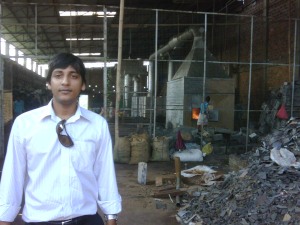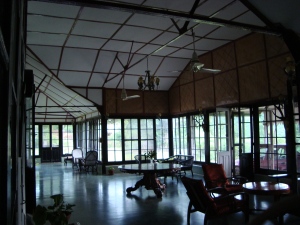Upon arrival in Guwahati, we noticed a barrage of modern ambulances with NRHM (National Rural Health Mission) logos imprinted on their side. A drive through Assam also revealed that NRHM has been well advertised in the state. In Sibsagar, we visited the civil hospital and noticed that the scheme was also being effectively implemented. In addition to being one of the most hygienic and orderly hospitals we have seen, doctors were attending to patients and medicines were being provided free of cost. We learnt that all this was made possible by Dr. Himanta Biswa Sarma, Assam’s Health, IT (Information Technology) and GMDA (Guwahati Metropolitan Development Authority) Minister.
While in Tezpur, our local host thought that it would be a good idea for us to meet Dr. Sarma, who is considered Assam’s most dynamic young leader. We wrote to him, introducing ourselves as a group of students exploring the country. He responded within 48 hours, promising to meet us after returning to Guwahati. Such responsiveness is generally uncharacteristic of a politician.
We were invited to his residence for dinner which was preceded by a long conversation in his work chamber. We began by asking him about his role in implementing NRHM across Assam. He told us that the successful execution was a result of district level planning, an inherent feature of the policy. He talked about India’s heterogeneity and told us that in order for a scheme to be successful, mandates can be national but states must be given entrepreneurial leeway in execution[1]. He also credited his team for looking after the micromanagement of the program. Dr. Sarma stated that he provides the vision[2] but responsibility and accountability are shared by the team.
We proceeded to ask him about his role as the GDD Minister. Dr. Sarma is not in favor of urbanization at the cost of agriculture. He lamented that agriculture is losing its prestige/importance and that in order for India to embark on a path of sustainable economic development, more Green Revolutions are needed. He spoke of Punjab as a showcase state which had benefitted from the introduction of advanced agricultural techniques, and where farmers have social clout. He longs for a day when the agricultural domain is considered prestigious enough for a father to get his daughter married to an agriculturist.
We also asked Dr. Sarma to shed some light on the subject of illegal immigration from Bangladesh into India. He urged us to consider the social impact of such migration (in the form of religious imbalance) in the long run, as opposed to the short term economic impact. According to him, Assam needs labor from outside the state as there are not enough locals available for low-skill jobs. He also thinks that the issue is not limited to Assam anymore as Bangladeshis travel to other parts of the country for work.
Dr. Sarma concerns himself with the attitude of the Assamese people. His mission is to transform the lackadaisical mindset of the local into an energetic and optimistic one. He believes in youthful enthusiasm and sees it as a game-changer in contemporary India. He travels extensively in order to familiarize himself with best practices in other regions. The conversation also revealed that he surfs the internet regularly and is an avid reader, especially of his critics. Watch out for this young leader who lends the political class much needed positivity.
[1] Here he suggested that policymakers from the southern part of the country are better equipped to design policy due to their preference for a decentralized form of governance as opposed to an overarching federal structure.
[2] According to him, those below 40 are the doers while the 40 plus generation is responsible for leadership and vision.





















